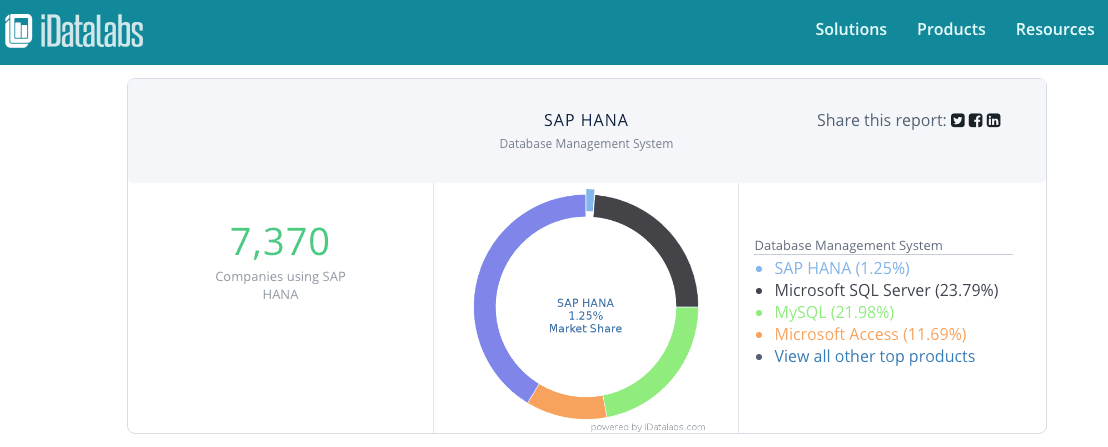Are SAP’s Layoffs Due to an Impressive Transformation?
Executive Summary
- SAP has come up with a logic for key layoffs in areas where their products are failing.
- We analyze the evidence for SAP’s logic.
Introduction
After we wrote our analysis of SAP’s layoffs in the articles SAP’s Layoffs and a Brightwork Warning on HANA, and What Is Different About the Q1 2019 SAP and Oracle Layoffs, we found the article Five Questions with SAP CTO Juergen Mueller on the SAP website. It provided SAP’s explanations for the website.
Let us see how SAP’s explanations hold up.
Our References for This Article
If you want to see our references for this article and other related Brightwork articles, see this link.
The Quotations
An Impressive Transformation?
“SAP News recently had the opportunity to speak with Juergen Mueller, chief technology officer and member of the Executive Board of SAP SE, on some of the important topics facing SAP and its customers and partners.
Here is a transcript of the conversation.
Q: Thanks, Juergen, for making the time. It’s obvious to most that SAP continues a rather dramatic and impressive transformation. There’s always speculation about what every announcement means about the company’s priorities. What’s your take on where SAP is today?
A: Personally, I believe SAP is in a very exciting position today. By any measure, we have assembled a comprehensive end-to-end portfolio of business solutions. We serve large and small customers in every industry in nearly every country. The key for us right now is to show two things: consistency and innovation. Innovation is an obvious requirement. I also stress consistency because just last year we introduced a significant strategy to deliver the Intelligent Enterprise.
Our customers need to see us continue to focus on this strategy, especially showing that our analytics and machine learning capabilities are infused into all of our business applications. The key here needs to be business value. What can a customer that runs SAP do as an intelligent enterprise that they could not do before? How can the SAP user community be leaders in their companies by connecting the operations to the experiences? I believe we have a strong technology story to tell, but this will only resonate if we help customers demonstrate the business value they achieve with SAP. There are so many of these stories to tell and we need to constantly put the customer success first beyond our own soundbites.”
Our Analysis
SAP has layoffs in many of the areas in which SAP has been unsuccessful. SAP Cloud, Leonardo, HANA, etc.. If the demand had materialized for the offerings, the layoffs would not have been necessary. However, SAP claims that we have not seen made anywhere: the layoffs are not layoffs or a sign of weakness in the layoff areas, but instead is an “impressive transformation.” The term digital transformation, which is a fake term that we covered in the article The Problem with the Term Digital Transformation, has led to the trend of companies calling any change or any setback as a “transformation.” SAP also claims that this is “obvious to most.”
It is not evident to us, and we can’t even recall a single comment putting this spin on the layoffs. Rather than being obvious, it is entirely counter to our conclusion about the layoffs. And this is PR. PR is how you try to get ahead of a story and try to shape the narrative around the story.
Mueller then begins his answer with a sort of boilerplate motivational speak. And he immediately starts by emphasizing the importance of innovation. What is curious is that the layoffs themselves show how lacking in innovation SAP has been. The evidence for innovation at SAP is feeble.
Here are a few examples.
- We have documented how HANA, a highly touted database by SAP for innovation, was based upon two acquisitions (acquisitions are not innovation). How SAP has simply backward engineered other databases as covered in the article Did SAP Reinvent the Wheel with HANA?
- There is also a complete lack of innovation in SAP Cloud, which will now be a system to upcharge customers for AWS/GCP/Azure, as we covered in the article How to Understand SAP’s Upcharge as a Service Cloud.
- S/4HANA is not at all innovative. It is a technical “rejiggering” of ECC’s backend that increasingly looks like it will be implemented on premises without Fiori.
Mueller then discusses machine learning, which many vendors also claim, but is just a bubble that will be popping shortly. If you look at SAP’s machine learning claims, you find that SAP has added some standard machine learning algorithms that it had nothing to do with developing to a few of its products, but it charges for them when they have been available for free for decades. We covered this topic in the article How Real is the SAP Machine Learning and Data Science Story? Any customer purchasing “machine learning” from SAP should contact us because you can get everything SAP is selling in ML for free. You need to know how to look for those items online.
It seems that SAP’s definition of innovation in ML is to sell publicly available ML algorithms.
Overall the first answer by Mueller is more of a diversion away from the question rather than an observation about the layoffs — which, again, are not called layoffs in the issue but an “impressive transformation.” As in Orwell’s 1984, War is Peace.
Do the Layoffs in HANA Point to Problems with HANA?
“Q: One quick follow up on your statement about SAP’s technology story. There is some speculation in a few places about the future of SAP HANA. You just became the leader of all SAP technology and innovation a few weeks ago. What is the future of SAP HANA?
A: To be candid, anyone who questions our commitment to SAP HANA doesn’t understand the strategy of SAP. We just named one of our brightest engineering leaders, Gerrit Kazmaier, to oversee the roadmap for SAP HANA data management.
The reality is that SAP HANA has been wildly successful for SAP and for our customers, with more than 28,000 customers on the SAP HANA platform. Almost all of our SAP applications, including SAP SuccessFactors solutions, make use of SAP HANA now. This turns it into one of the largest scale — if not the largest scale — enterprise application database.
Given the scale it has achieved already, we look to constantly build on the past success by introducing new SAP HANA offerings. We will make some major announcements about SAP HANA at SAPPHIRE NOW in a few weeks.
Honestly, I read some of these articles and they are basing assumptions about SAP HANA on a restructuring program that was announced earlier this year. I don’t want to minimize the anxiety that a restructuring creates for employees who are impacted. In cases where individuals make comments about their feelings or they question specific decisions, this is understandable. Personally, my hope is that SAP or our partners retain as many of these colleagues as possible. The facts about the strategy itself are what I have explained here. The restructuring is designed to invest more of our resources in areas where SAP customers tell us they expect us to invest. New SAP HANA innovation is one of those key priority areas.”
Our Analysis
First off, it is unclear who understands SAP’s strategy, as the following graphic explains.

Blaming people for not understanding what SAP’s “strategy” is, is not a true critique if it is not knowable. This is a constant feature of SAP messaging, that if their behavior appears erratic or illogical, the fault lies with people that “don’t understand ABC or XYZ. Sometimes things don’t make any sense.
Loosely stated, it seems to be “get involved in a lot of stuff.”
As we have covered in articles like Why Did SAP Stop Reporting HANA Numbers After 2015?, HANA’s growth plateaued in 2015 when they switched the narrative to S/4HANA. HANA is a costly database with no differentiation in the market. How Were SAP’s Claims True if HANA is Now Not a Differentiator?
SAP Can Not Afford to Continue to Invest What it Has in HANA
This means that SAP is not receiving a return to make HANA the primary marketing tentpole that it once was.
We covered in the article HANA’s Time in the Sun Has Finally Come to an End in mid-2018 that SAP would reduce its marketing and development and overall investment in HANA because it did not make sense to continue to do so. Now, less than a year later, SAP is doing what we predicted they would do, but we have been told to please not emphasize this fact. Accenture, Deloitte, Infosys, and Gartner, along with every HANA resource, would rather not have it published that all the information they have been telling their customers about HANA has been false.
Therefore, while HANA is not going to be discontinued as a product, it will not receive the same emphasis or internal resources as it did in the past.
Meuller tells several lies in his response.
- The fact that SAP promoted a new individual to a position in HANA does not mean anything. It has not mattered who had that position in the past because HANA’s design objectives are illogical because they were initially set by Hasso Plattner, who was unqualified to design a database.
- HANA is not live at 28,000 companies. It is owned as a license by that many companies. HANA does not have more than roughly 8,000 live customers. How do we know? Well, SAP’s stopped reporting live customers in 2015 for a reason.

iDataLabs makes its money by selling data to salespeople. Unlike SAP, they have no incentive to overestimate or underestimate HANA’s usage. This means that even with all of SAP’s marketing push since 2011, SAP could not make HANA anything more than a niche database.
- SuccessFactors is on HANA?: SAP customers are not live on SuccessFactors on HANA. SAP is still testing an internal version of SuccessFactors on HANA, as we covered in the article Did SAP Move SuccessFactors to HANA?
- Analysis of Layoffs is Too Narrow?: Our analysis, which Mueller may be referring to as our articles on SAP’s layoffs, has been very widely read. We know they have been discussed within SAP as they did not provide the desired spin on the layoffs, which is not merely based upon the layoffs alone. They are based upon field reports related to HANA and based upon years of research into HANA.
- SAP Does Not Think Enough of HANA’s Prospects to Maintain a Large Contingent of HANA Resources, but Thinks Their Consulting Partners Should?: There is little reason to retain a good part of HANA resources if HANA is never going to meet the projections that the company had for it. Consulting companies keep resources staffed for one reason, to be able to staff those resources. When one of the top resources in HANA in SAP, Thomas Jung, states that he wants to leave HANA to get “closer to his ABAP roots” that should tell you something about HANA’s future.
- HANA’s Future Priority?: We can’t predict HANA’s exact priority in the future, but it is going to be reduced.
Do the Layoffs in HANA Point to Problems with Leonardo?
“Q: Another big topic we hear about in some parts of the market is around SAP Leonardo. As this is also part of your portfolio, what do you want people to know about SAP Leonardo? What do customers need to know?
A: Customers need to know that we have amazing engineers who are building more and more use cases with SAP Leonardo technologies embedded in our actual applications. This is what I was saying earlier about putting business value discussion before technology discussion. Look at companies like Pregis in the U.S., which is using SAP Leonardo Internet of Things (IoT) technology to monitor and analyze its machines. You even see SAP Leonardo Blockchain examples with Bumble Bee Foods tracing tuna from sea to the store shelves.
Machine learning use cases in our applications are expanding rapidly, and their impact can be seen in every industry. In fact, we have 100 unique machine learning-enabled scenarios, embedded in every SAP application, from SAP Fieldglass to SAP S/4HANA.
Another example of how customers benefit from intelligent technologies is BNP Paribas: The banking group was able to reduce customer on-boarding process for Hello bank!, its online bank, from 25 minutes to less than five minutes by using intelligent robotic process automation.
Maybe the one thing I wish we had done differently when we began promoting SAP Leonardo is to make the argument clearer to our customers that if you run SAP applications, you are going to benefit from SAP Leonardo innovation. This is a fundamental piece of our intelligent enterprise strategy and it’s only going to accelerate.”
Our Analysis
Mueller is lying in this explanation. In the article Our 2019 Observation: SAP Leonardo is Now Dead, we covered that Leonardo will disappear as a product. SAP cannot succeed with Leonardo because IoT is based upon open source components (which SAP is never successful with). And IoT is not inherently tied to the ERP system, which is how SAP sells all non-ERP applications into their account base. SAP can typically get a few companies to invest in something like Leonardo, but these are just custom development projects. Information from those that have worked with Leonardo state that it is not a product. SAP will create a custom solution for you if you pay them. But it is not a packaged solution.
Machine learning is not expanding in SAP.
Mueller’s entire response is false. The layoffs hit Leonardo because Leonardo is not relevant for customers, they are not buying, Leonardo’s resources are not needed.
What is SAP’s Biggest Challenge?
“Q: What is SAP’s biggest challenge and its biggest opportunity?
A: Our biggest challenge is to stay focused on our customers. It is so tempting in the technology industry to get carried away with buzzwords and “new breakthroughs.” The reality is that we are here to help companies extract value from technology, which is very different than simply celebrating every new idea. Customers expect us to be innovative, but also to protect them by making technology scalable in the global economy.
Our biggest opportunity is to connect enterprise technology to the individual, whether that’s the end consumer or the employee. This is the one boundary of enterprise technology that hasn’t been crossed. I am very confident we can do it and that we can improve people’s lives in the process. This is why you have only just begun to hear about the importance of experience data in addition to operational data.”
Our Analysis
SAP is all about buzzwords. Meuller used numerous buzzwords such as machine learning, IoT, blockchain, etc.. And these are buzzwords that have just about nothing to do with SAP’s business.

If you are using the term blockchain to fill the gaps in your life or make yourself seem more interesting than you. If so, you need to talk to your doctor about why you feel the need to use this term.
So it is odd to read a few paragraphs later about how it is tempting to get carried away with buzzwords—a major problem with Mueller’s predecessor, Bjorn Goerke.
The things Bjorn Goerke said did not come true and were often misleading. Who attended a session with Goerke and said: “yes, I am getting the real story here.” The misinformation in this interview with Ray Wang comes fast and hard. Entirely left out of this discussion is how SAP is marking up cloud services between 3x and 10x.
Virtually nothing that Bernd Leukert said would happen came true. SAP has a distinct shortage of people in top positions who will tell the truth. If all the top people are good for repeating false information, it will be impossible for SAP to make the changes they need to improve.
Now both Leukert and Goerke are gone from SAP. However, Mueller does not seem like he will be saying anything true during his tenure. Then Mueller will be gone in a few years, replaced by another practicer of make-believe. These characters all say about the same things, so there might be an AI robot writing these comments, and Leukert and Goerke et al. are hired, actors. At this point, who can tell the difference.
The rest of Mueller’s quote does not give us anything to analyze because it lacks any content.
Conclusion
Several SAP resources critiqued our analysis of SAP’s layoffs. A month ago, we were told by many SAP resources not to comment on the layoffs. That it was “inappropriate.” However, Mueller now has commented on the layoffs, and it is doubtful any SAP resources will state that it was inappropriate for Mueller to comment. The concept here is that only SAP should be allowed to comment on their layoffs and that all of those that work in SAP or research SAP should look to one source for what the layoffs mean — which is SAP’s PR department. However, unlike any of the PR-controlled explanations provided in this article from SAP, our analysis actually made sense.
This explanation offered by Meuller makes no sense and is pure PR fiddle-faddle. But maybe this is what SAP resources want, a completely inert and false explanation that makes SAP look as good as possible. If so, this is the article to read if one wants to learn absolutely nothing about the layoffs’ real reasons.
However, if you work in SAP, listening to Mueller’s explanation is bad because it will prevent you from making adjustments. SAP is making these adjustments but does not want the outside world to understand what they mean.
